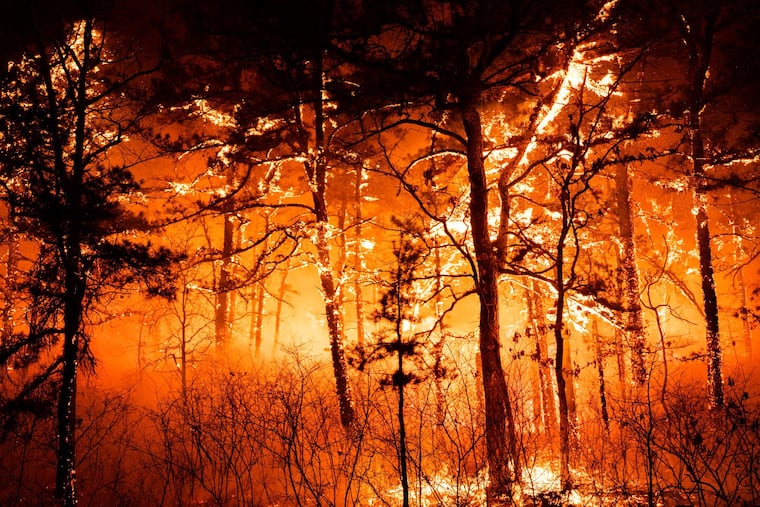Hot times are here for the Philly region. Is nature skipping another season?
Near-record high is possible Thursday. April is prime season for dry heat, wildfires, and "hay fever."

Temperatures are expected to make a run at a record high in Philly on Thursday, and meteorologists say this run of June-like warmth is very much related to the conditions that led to the wildfires that have scorched nearly 4,000 acres of South Jersey woodlands.
Unusually moisture-deprived air has settled over the region, and over much of the nation, in what has been quite the pattern change.
“For the first time in weeks we don’t have a parade of storms coming across the country with severe weather outbreaks in the Midwest and Plains, and Gulf moisture streaming north with rain,” said Bob Larsen, senior meteorologist with AccuWeather Inc. “So it’s not only storm-free, but humidities are way down.”
» READ MORE: 'A wall of fire' scorches the Pinelands
In fact, it’s almost as though a huge chunk of the country got stuffed into a dryer this week. Dry conditions led to a rash of red-flag fire alerts on Wednesday that covered all of Pennsylvania and an area arcing from Michigan to New Mexico’s border with Mexico.
All that dryness, combined with the general lack of shade-creating foliage, has allowed temperatures to spike. Combined with winds, the dry run also generated ideal conditions for wildfires.
The wildfire danger is expected to back off some on Thursday as winds slacken a bit.
The heat, on the other hand, will ratchet up a shade, with temperatures in Philadelphia forecast to make a run at the record for the date, 89 degrees, set in 1977. Friday’s reading is due to head back to the mid 80s.
And though it may seem that after a nonwinter the atmosphere is fast-forwarding to summer, climate change notwithstanding, premature heat is not all that unusual, said Bob Larsen, senior meteorologist with AccuWeather, in State College.
Something about April
“We often do see these early-season heat waves,” he said. The temperature has reached 90 as early as April 7. That was in 1929.
The days are getting longer, the sun angles becoming more direct. The leafage still has a long way to go, so still absent is the rain-retaining foliage that evaporates and contributes moisture to the air, bumping up the humidity.
A lack of humidity holds down the heat index and, thus, it is highly unlikely that a heat advisory would be issued around here in April.
» READ MORE: The April sun was a factor in the Philly region's recent tornado outbreak
Philly has had some impressive April hotshots. One of the all-timers occurred in 1976 when the temperature peaked at 94 degrees on the 18th, the second-highest reading ever recorded in Philadelphia in April, behind the 95 of April 17, 2002.
Larsen noted that just before the heat ramped up in April 1976, it was quite chilly, and that was basically the result of the same, dry area of high pressure that had migrated from Canada.
Dry out
Winds circulate clockwise around centers of highs, thus the region felt the chilly north winds as the system approached, and its warm winds from the south as it moved off the coast, he said.
Similarly, this time around, you might recall that temperatures dropped below freezing in parts of the region early Monday.
Once again, a dry air mass that had ripened atop a snow cover dropped southward from Canada, said Ray Martin, a lead meteorologist at the National Weather Service Office in Mount Holly.
Its approach coincided with a cooldown, followed by this warmup. Thursday’s high may be the highest since Sept. 19, while it was still astronomical summer.
Looking ahead
Spring is due to return during the weekend with temperatures no higher than the 70s, and not getting out of the 60s on Monday and Tuesday.
» READ MORE: Here's when it should be warm enough to plant vegetables
As to what a warm April interlude might mean for summer, an April hot spell in 1977 was followed by quite a toasty summer.
Conversely, the 1976 hot spell turned out be warmer than anything that followed that summer, which emptied into a cool fall, followed by an all-time cold winter on record in Philly.